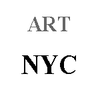
Hijo Nam Solo Exhibition
September 18 - October 15, 2025 | New York
Opening Reception_ Friday, September 26, 2025, 6-7pm
Threads of Origin
The solo exhibition of Hijo Nam at The foundation of ART NYC New York refuses to be confined to a single medium or form. In this presentation, fabric works, mother-of-pearl moon jars, and painterly canvases intersect and converse, creating a polyphonic space that explores the origins of human existence, the spiritual realm, and the sustaining force of maternal love. Nam’s art weaves Korean tradition, contemporary experimentation, material tactility, philosophical thought, ritual memory, and personal myth.
Fabric has long been central to Nam’s practice. The repeated acts of tearing, stitching, layering, and mending are not mere techniques but metaphors for life itself. Wounds and healing, death and rebirth, separation and reunion are inscribed into cloth as both visual and tactile experiences. Fabric enfolds the viewer like a swaddling cloth, recalling the ritual textiles of shamans, mediating between visible and invisible worlds. In its trembling folds and shifting light, fabric becomes a threshold where time, memory, and spiritual currents converge. Yet this exhibition extends beyond fabric. Including mother-of-pearl moon jars situates Nam’s work within the lineage of Korean aesthetics while expanding it to a cosmic dimension. The moon jar, regarded as a symbol of purity and wholeness, historically embodied infinity through emptiness. Nam transforms the vessel into a radiant container of beginnings by embedding mother-of-pearl. Its iridescent surface refracts like moonlight, evoking time cycles, maternal embrace, and the fragile tension between permanence and transience. Her paintings introduce another stratum. Layers of brushstrokes, traces, erasures, and overlays do not simply stand for but record. Each canvas becomes a site of inscription where memory, ritual, and personal myth unfold. These works function as both image and object, surface, and body, extending the tactility of fabric and the solidity of porcelain into the pictorial realm. Nam’s abstraction is never reduced to formal experiment or empty imagery. Instead, it is rooted in a concrete investigation into ancient human origins and spiritual experience. She has looked to understand how humanity interpreted life and death, inscribed communal origins into cloth, vessels, and walls, and kept connections with the unseen. Thus, her abstraction is anchored: it draws upon ancient narratives and spiritual experiences to open all stories. Crucially, Nam’s inquiry has not still been abstracting or symbolic. She undertook direct field research at Lake, a place deeply tied to shamanic traditions, in pursuit of the origins of ancient shamans’ sophisticated philosophies and knowledge systems. She cross-verified historical texts published across different countries, building a solid scholarship foundation for her artistic inquiries. Beyond academic rigor, Nam has also embodied shamanic practices—performing meditative rituals that look to dissolve the boundaries of time and space. This dual commitment to research and practice lends her work a distinctly anthropological and experiential weight, situating her art at the confluence of ancient knowledge systems and contemporary artistic practice. In this light, fabric, moon jars, and paintings no longer appear as separate media but as interwoven voices. Softness, solidity, and fluidity converge to form a cosmology of origins. Origin here is not a fixed point in the past but a cyclical present, continuously reborn—a primordial ground to which we are invited to return. At the heart of Nam’s art lies the force of maternal love. For her, it is not a private symbol but a universal energy, the foundation of existence. Fabric enfolds like a mother’s embrace, the moon jar radiates cyclical protection, and the painting inscribes the scars and traces of memory. Maternal love thus becomes more than a gendered metaphor—it becomes the archetype of origin itself.
This exhibition is both a declaration and a question. Where have we come from, what binds us together, and where must we return? Nam does not leave these questions abstract; she stages them as lived experiences. Visitors walk along the textures of cloth, meet the spectral shimmer of mother-of-pearl, and inscribe their own memories upon painted surfaces. In this moment, the exhibition expands into a collective meditation on spiritual continuity and humanity’s ancient origins.
Threads of Origin resists the speed and consumption logic dominating contemporary art. It is not a regression into the past but a re-weaving of the present through countless threads of beginning. Through abstraction rooted in spiritual experience and historical investigation, Nam translates ancient knowledge into the language of art. Her work becomes where all stories open, bringing us face to face with life and death, memory and healing, maternal love, and the power of origin.
References
- Geertz, C. (1973). The Interpretation of Cultures. New York: Basic Books.
- Kristeva, J. (1982). Powers of Horror: An Essay on Abjection. New York: Columbia University Press.
- Lévi-Strauss, C. (1963). Structural Anthropology. New York: Basic Books.
- Turner, V. (1969). The Ritual Process: Structure and Anti-Structure. Chicago: Aldine Publishing.
- Warner, M. (2000). No Go the Bogeyman: Scaring, Lulling, and Making Mock. New York: Farrar, Straus and Giroux.

